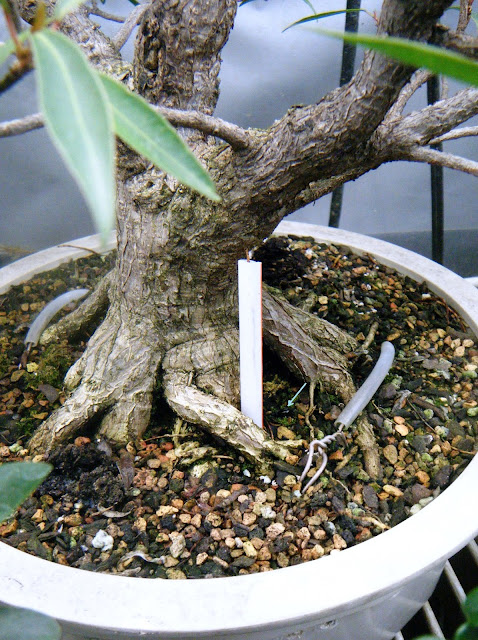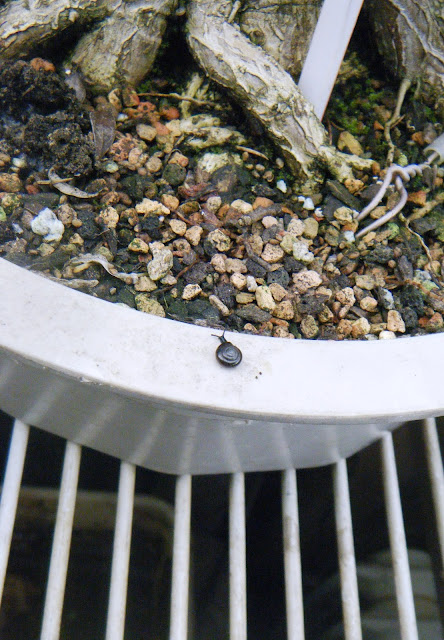I said in my last post that if a tropical-bonsai grower wants an aerial root in a given place, he or she usually has to hope the tree will throw one at that point. I was happily surprised a few weeks ago when one of my willow-leaf figs (Ficus salicaria) decided to do almost exactly that.
And then a week or so later, I discovered that my veldt fig (Ficus burtt-davyi) had followed the willow-leaf's example!
 |
| This mame F. burtt-davyi is one of my favorite bonsai. Pot by Sara Rayner. |
The orange arrow points to the root that got a response of "Yes! Where I want one!" (Or words to that effect.) I've been hoping for an aerial there for several years. I want an aerial root on this tree for the tropical look, but just one because of the tree's size. And I want it where it's readily seen, but won't compete visually with the hollow trunk. This root's placement is perfect!
 |
| The paper-clip hook (green arrow) is there to keep an older root from crossing the end of the new aerial. |
Forgive this tree's mildly disheveled look: I'm getting it cleaned up for repotting in the near future.
Meanwhile, the willow-leaf fig about which I wrote in my last post has produced the beginnings of a couple more aerials!
 |
| Besides shade and high humidity, plenty of fertilizer seems to be a requirement for initiating new aerial roots. |
The blue arrow points to an emerging initiation point. Below it you can see the root I wrote about in my last post, now matured enough to have the straw removed. (You remove a straw from a new aerial the same way you defuse a bomb - very carefully.)
Some aerial roots fail, and sometimes without apparent reason. The yellow arrow above points to another aerial that got started, but was already in trouble when the picture was taken. Five days later, it has withered completely.
Since I don't want this new one to fail, I cut a new length of drinking straw to protect and guide it. This tree's size and intended design allow for more than one aerial in that area.
 |
| The point where each aerial enters the soil can be adjusted at future repottings. Once an aerial root lignifies, it can be wired and positioned like a branch. |
On the opposite side of this tree's trunk (red arrow below,) another root-initiation point has appeared. (We need a a less cumbersome term for such point. Any ideas?) I'd like to see this one develop successfully as well, so am going to give it a drinking-straw cover too.
 |
| If, like me, you endured acne as a teenager, you'll understand when I say I'm reminded of a pimple! |
When I saw this picture, I thought perhaps yet another root initiation point was showing up, out on a major branch (green arrow.) But no joy there: the "bump" turned out to be nothing more than a scrap of loose bark.
I should mention that there is another way to get an aerial root at just the point you want it: graft in a seedling or rooted cutting. That takes longer, but provided the graft takes well and without much swelling, it works. I plan to use that method on a Ficus microcarpa this summer, and I'll post pictures when I do.
Meanwhile, the tropical trees will be in the Crate for at least two more months. Who knows how many more aerial roots may appear before spring? ☺
:-) :-) :-)



